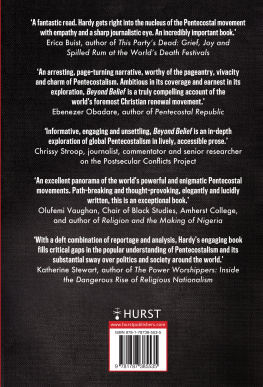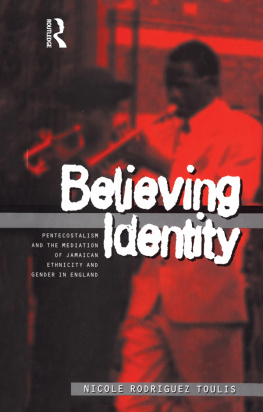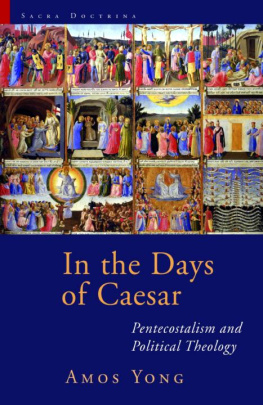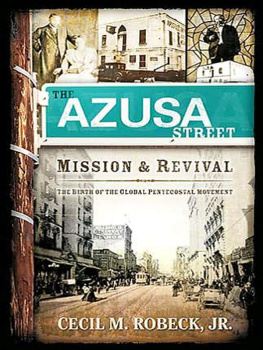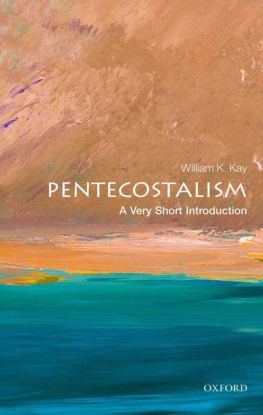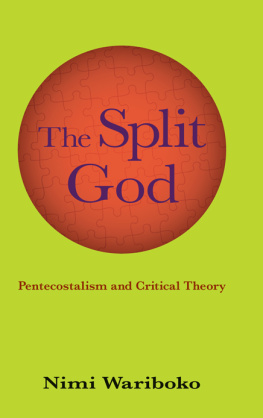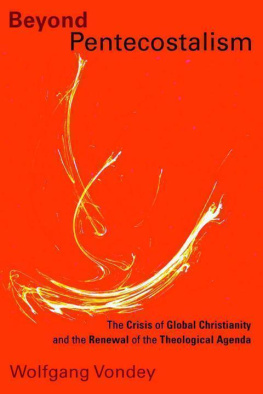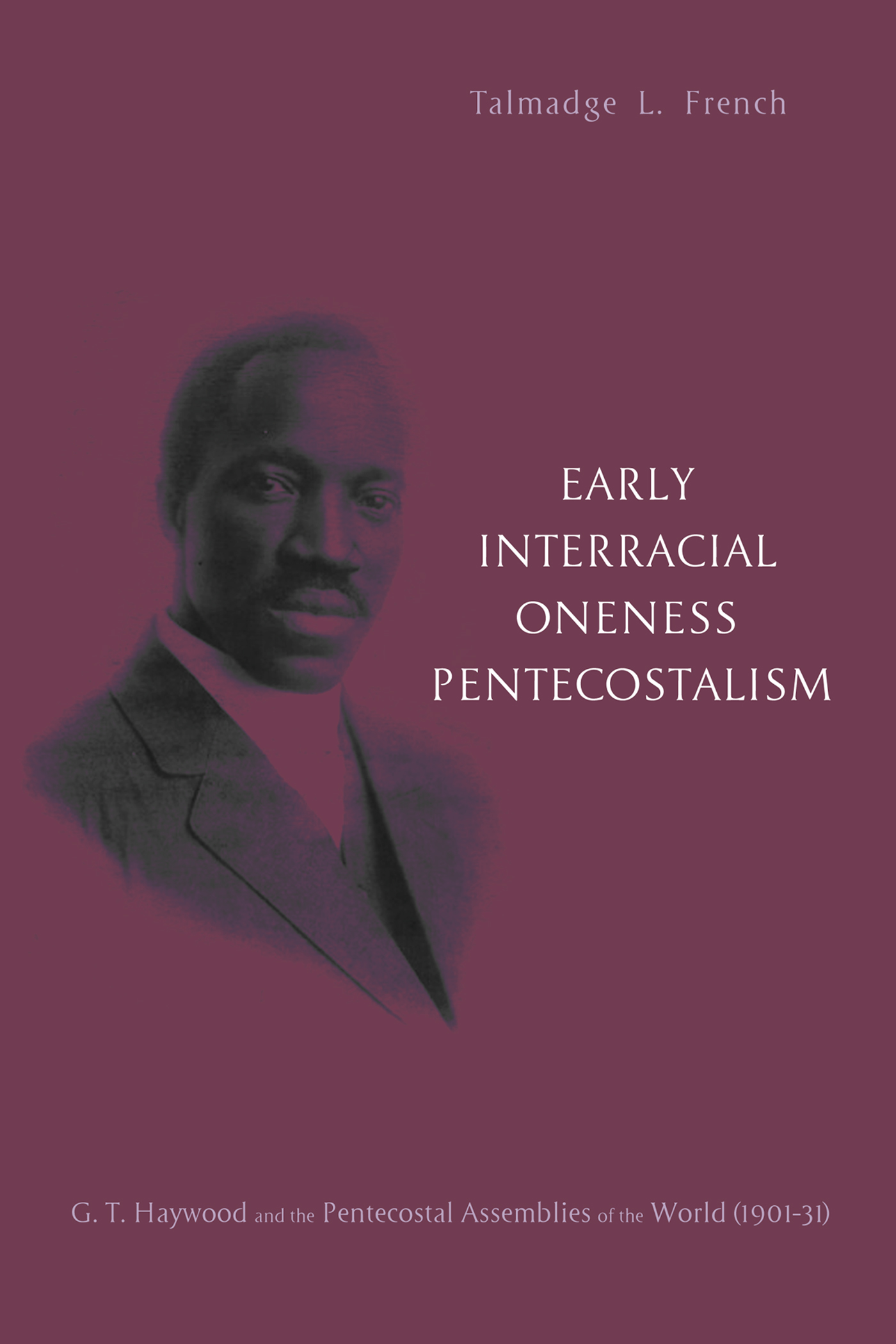Early Interracial Oneness Pentecostalism
G. T. Haywood and the Pentecostal Assemblies of the World
(19011931)
Talmadge L. French

Early Interracial Oneness Pentecostalism
G. T. Haywood, and the Pentecostal Assemblies of the World ( 1901 1931 )
Copyright 2014 Talmadge L. French. All rights reserved. Except for brief quotations in critical publications or reviews, no part of this book may be reproduced in any manner without prior written permission from the publisher. Write: Permissions, Wipf and Stock Publishers, W. th Ave., Suite , Eugene, OR 97401 .
Pickwick Publications
An Imprint of Wipf and Stock Publishers
W. th Ave., Suite
Eugene, OR 97401
www.wipfandstock.com
isbn : 978-1-62564-150-2
eisbn : 978-1-63087-321-9
Cataloguing-in-Publication data:
French, Talmadge L.
Early interracial oneness pentecostalism : G. T. Haywood and the pentecostal assemblies of the world ( 1901 1931 ) / Talmadge L. French, with a foreword by Allan H. Anderson.
xvi + pp. ; cm. Includes bibliographical references and indexes.
isbn : 978-1-62564-150-2
Haywood, G. T. (Garfield Thomas). Oneness Pentecostal Churches. African American PentecostalsHistory. I. Anderson, Allan H. II. Title.
BR1644.3 F824 2014
Manufactured in the U.S.A.
Foreword
S everal Pentecostal groups arose in the United States in the 1910 s and 1920 s with a doctrine called Jesus Name, Apostolic Pentecostal, or Oneness by its proponents, and the New Issue, or Jesus Only by its opponents. I had the privilege of supervising Talmadge Frenchs PhD research on this subject over several years at the University of Birmingham. His research was meticulous and thorough, not leaving any stone unturned in his search for facts. Oneness Pentecostals, according to French, have some thirty million adherents worldwide, which makes them a significant minority within classical Pentecostalism. French is one of a handful of Oneness Pentecostal ministers with a PhD, and this historical study is unique, not least because he is an insider who manages to maintain critical distance from his subject, one that is also very close to his heart. Originally conceived as a study of the origins of Oneness Pentecostalism in one American city, Indianapolis, Indiana; it developed into a study of the most prominent African American leader in early Finished Work Pentecostalism, Garfield Thomas Haywood, also in Indianapolis; and then developed further to an analysis of the interracial nature of early American Oneness Pentecostalism spread across the United States, in which Haywood played a prominent role. Haywood was undoubtedly a most remarkable man whose achievements in attaining racial integration in an era of Jim Crow segregation laws that were de jure in the South and de facto in the North, were nothing short of amazing. This fascinating story with all its original sources is the result of these years of research.
Oneness Pentecostalism is an enigma to most scholarsof all forms of Pentecostalism globally today this form appears, at least to this observer, to have maintained most closely the countercultural and otherworldly character of early Pentecostalism. As French shows in this book, the interracial fervor of early American Pentecostalism remained in Oneness Pentecostalism longer than in other sections of the movement. There remains a deep divide between Oneness and other forms of Pentecostalism, largely on doctrinal grounds. It has been regarded by other Pentecostals variously as heretical or heterodox. The main issue is its Sabellian Modalistic approach to the Trinity, and the doctrine that baptism in the name of Jesus and Spirit baptism with speaking in tongues is necessary for salvation that is promulgated in many, but not all, Oneness circles. This is not a homogenous organization, for like Pentecostalism as a whole, Oneness Pentecostalism has split into many different groups independent of each other. The two largest in North America are the Pentecostal Assemblies of the World and the United Pentecostal Church International. There are even bigger Oneness Pentecostal groups in Ethiopia: the Apostolic Church of Ethiopia, and in China and the Chinese diaspora: the True Jesus Church. The latter has imbibed some of the features of Seventh-Day Adventism into its teachings and observes Saturday as the Sabbath. Most forms of Oneness Pentecostalism also practice foot-washing.
It might be helpful first to give a potted history and theology of early American Oneness Pentecostalism for the uninitiated, even though such a summary has to be arbitrary and selective. Racial, doctrinal and personal issues simultaneously caused the divisions that erupted in early American Pentecostalism. The first Pentecostals at Azusa Street under their African American leader William Seymour were in an integrated and socially inclusive movement of the Spirit. This was what French called an interracial vision. Although Pentecostalism has its roots in the nineteenth century Holiness movement, some adherents had come from churches outside of this, and were more influenced by the Keswick view of progressive sanctification, which tended to deny a second instantaneous experience of holiness. William Durham in Chicago was undoubtedly one of the most influential Pentecostal preachers and the cause of the first major doctrinal schism in the movement. His Gospel Mission Church, also known as the North Avenue Mission, became a revival center that rivalled Azusa Street in influence and indirectly resulted in the creation of several European immigrant Pentecostal congregations in Chicago that spread worldwide.
In 1911 Durham, once so influenced by Azusa Street, went to the Azusa Street Mission to preach his Finished Work of Calvary doctrine in Seymours absence, which resulted in schism and the departure of two-thirds of Seymours workers. The Holiness teaching of entire sanctification, which had been embraced by Seymour and most early Pentecostals, Durham declared to be unscriptural, teaching that sanctification was not a second blessing or a crisis experience, but that Christ had provided for sanctification in his atonement and that this was received at conversion by identification with Christ in an act of faith. He therefore taught a two-stage work of grace (justification and Spirit baptism) instead of a three-stage one. His theology was thoroughly Christocentric, and it could be argued, deviated significantly from the Spirit-centered theology of both the Holiness movement and the first American Pentecostals. Durhams influence was enormous. Many of those who became major leaders of the Pentecostal movement embraced the Finished Work doctrine, including those who became leaders of Oneness Pentecostalism. After Durhams premature death from tuberculosis in , his doctrine became the basis upon which the Assemblies of God, the Oneness denominations, the Foursquare Church, and several other smaller Pentecostal denominations were formed. Durhams assistant minister, Frank Ewart, who also became a Oneness leader, led the North Avenue Mission after Durhams death. There has been speculation that had he lived, Durham himself might have embraced Oneness, and that his Jesus-centered doctrine inevitably led to Oneness teaching. By 1914 some sixty percent of all American Pentecostals had embraced the Finished Work position. Durhams influence on the theology of the majority of Pentecostals was certainly immense and the division in US American Pentecostalism on this issue remains today.


